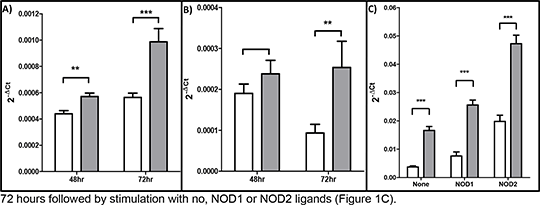The Role of DNA Methyltransferase Inhibitors in the Regulation of NOD-like Receptor Expression and Activity in Monocytes NOD-like receptors (NLRs) are a class of pathogen recognition receptors, which play a vital role in the innate immune response (1). Upon stimulation, these receptors promote the production of pro-inflammatory cytokines (2). DNA methylation, carried out by DNA Methyltransferases, is an epigenetic modification that has been shown to modify gene expression (3). At present, it is not know exactly what regulates the expression of NLRs. We hypothesise that DNA methylation may play a role. The main objective of this study was to investigate NOD1 and NOD2 gene expression following exposure to a DNA Methyltransferase inhibitor, 5-Azacytidine, with subsequent pro-inflammatory cytokine expression studies to establish NOD1 and NOD2 receptor activity following treatment. THP-1 monocytic cells were either untreated (UT) or exposed to 5µM 5-Azacytidine (5-Aza) for 48 or 72 hours, after which time cells were either analysed or stimulated with NOD1 (iE-DAP) or NOD2 (MDP) ligands for 6 hours prior to analysis (n ≥ 3). The analysis of cells involved RNA extraction, reverse transcription with subsequent quantitative polymerase chain reaction (qPCR) of cDNA samples. NOD1 expression significantly increased after 48 hours and 72 hours compared to untreated cells (Figure 1A). NOD2 expression was significantly higher after 72 hours (Figure 1B). Tumour Necrosis Factor-alpha (TNF-α) expression significantly increased after exposure for 72 hours followed by stimulation with no, NOD1 or NOD2 ligands (Figure 1C). 
Figure 1: 2-ΔCt Representation of Gene Expression. A) NOD1 Expression in untreated cells vs 5µM 5-Azacytidine treated cells. B) NOD2 Expression in untreated cells vs 5µM 5-Azacytidine treated cells. C) Tumour Necrosis Factor-alpha Expression after no, NOD1 or NOD2 ligand stimulation of 72hour untreated cells vs 5µM 5-Azacytidine treated cells. (p<0.05, represented by *, p<0.01 represented by ** and p<0.001 represented by ***). This study has uncovered, for the first time, a relationship between methylation and NLR expression, suggesting DNA methyltransferase enzymes or their inhibitors could control the innate immune response. 1) Kanneganti, T. D., Lamkanfi M. and Nunez G. (2007). Immunity 27(4): 549-559. 2) Chen, G., Shaw M. H., Kim Y. G. and Nunez G. (2009). Annu Rev Pathol 4: 365-98. 3) Yu, N. K., Baek, S. H. and Kaang B. K. (2011). Mol Brain 4: 5.
|


